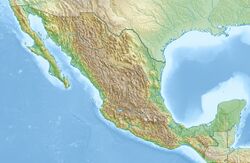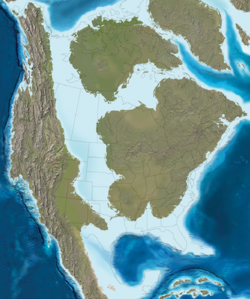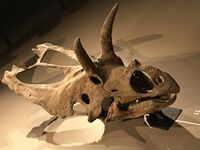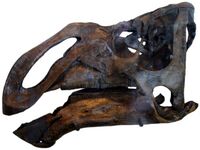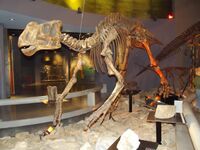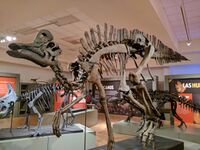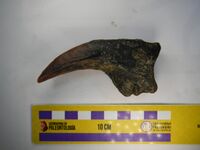Earth:Cerro del Pueblo Formation
From HandWiki
Short description: Geological formation in Mexico
| Cerro del Pueblo Formation Stratigraphic range: Campanian ~73.6–72.7 Ma | |
|---|---|
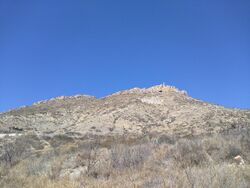 | |
| Type | Geological formation |
| Unit of | Difunta Group |
| Underlies | Cerro Huerta Formation |
| Overlies | Parras Shale |
| Thickness | 160 m (520 ft) |
| Lithology | |
| Primary | Mudstone, sandstone |
| Other | Siltstone, conglomerate, limestone |
| Location | |
| Coordinates | [ ⚑ ] : 26°06′N 101°06′W / 26.1°N 101.1°W |
| Paleocoordinates | [ ⚑ ] 32°12′N 75°30′W / 32.2°N 75.5°W |
| Region | Coahuila |
| Country | |
| Extent | Parras Basin |
The Cerro del Pueblo Formation is a geological formation in Coahuila, Mexico whose strata date back to the Late Cretaceous. Dinosaur remains are among the fossils that have been recovered from the formation.[1] The formation is believed to correlate with the Baculites reesidesi and Baculites jenseni ammonite zones, which dates it to 73.63-72.74 Ma.[2]
Dinosaurs
Ornithischians
Remains of the following ornithischians have been found in the formation:[3]
Ankylosaurs
| Ankylosaurs of the Cerro del Pueblo Formation | ||||
|---|---|---|---|---|
| Genus | Species | Material | Notes | Images |
| Ankylosauria[3] | Indeterminate[3] | A femur fragment, phalanx and a possible osteoderm.[3] | Indeterminate ankylosaur remains.[3] | |
| Ankylosauridae[3] | Indeterminate[3] | Osteoderms.[3] | Indeterminate ankylosaurid remains.[3] | |
| Nodosauridae[3] | Indeterminate[3] | A caudal vertebra, osteoderms and a tooth.[3] | Indeterminate nodosaurid remains.[3] | |
Ceratopsians
| Ceratopsians of the Cerro del Pueblo Formation | ||||
|---|---|---|---|---|
| Genus | Species | Material | Notes | Images |
| Centrosaurinae[3] | Indeterminate[3] | A partial right squamosal.[3] | Probably represents a new taxon.[3] | |
| Ceratopsidae[3] | Indeterminate[3] | Squamosal fragment, metatarsal, metacarpal, sacral vertebrae, proximal end of femora, proximal end of ulna, possible frill fragments and teeth.[3] | Indeterminate ceratopsid remains.[3] | |
| Chasmosaurinae[3] | Indeterminate[3] | Supraorbital horncores, an orbit, dorsal vertebra, indeterminate cranial fragments, limb bones, and unspecified postcranial elements pertaining to juvenile specimens.[3] | Indeterminate chasmosaurine remains belonging to juvenile specimens.[3] | |
| Coahuilaceratops[4] | C. magnacuerna[4] | A rostral, premaxilla, maxilla, nasals, supraorbital horncores, parietosquamosal fragment, predentary, and dentaries of an adult specimen and predentary, and dentary of a juvenile specimen, metacarpals, metatarsals, dorsal vertebrae, cervical vertebrae, caudal vertebrae, ulna and tibia.[4][3] | A chasmosaurine ceratopsid represented by an adult and juvenile specimen.[4][3] | |
Ornithopods
| Ornithopods of the Cerro del Pueblo Formation | ||||
|---|---|---|---|---|
| Genus | Species | Material | Notes | Images |
| Hadrosauridae[3] | Indeterminate[3] | A braincase, postorbital, quadrate, laterosphenoid, dentaries, mandibles, maxillae, cervical vertebrae, dorsal vertebrae, sacral vertebrae, caudal vertebrae, neural spines, ribs, ilium, femora, fibulae, tibiae, humeri, ulnae, metatarsals, metacarpals, pedal phalanxes, pedal phalanges, pedal ungula, phalanges, phalanxes, various bone fragments, fibulae, scapulae, radii, coracoids, astragali, indeterminate pelvic bones, ossified tendons, isolated teeth and integumentary impressions.[3] | Indeterminate hadrosaurid remains from numerous specimens.[3] | |
| Kritosaurus[5] | K. navajovius[5] | Predentary, symphyseal processes, rostral portion of dental battery of dentaries, rostral region of premaxillae, and fragments of maxilla.[5] | A kritosaurin hadrosaurid, referred to K. navajovius.[5] | |
| Lambeosaurinae[3] | Indeterminate[3] | Maxillae, premaxillae, quadrate, partial braincase, dentaries, cervical vertebrae, dorsal vertebrae, sacral vertebrae, caudal vertebrae, neural spines, ribs, ilia, ischium, femora, fibulae, tibiae, humeri, ulnae, metatarsals, metacarpals, pedal phalanges, phalanges, pedal unguals, astragali, radii, scapulae, pubes and other unprepared elements.[3] | Indeterminate lambeosaurine remains from numerous specimens, including a large hadrosaurid.[3] | |
| Latirhinus[6] | L. uitstlani[6] | Caudal vertebrae, scapulae, humeri, ulnae, coracoid, metacarpals, manual ungual, ilia, ischia, femora, tibiae, fibula, and astragalus.[6] | Holotype specimen is chimeric as it consists of multiple individuals. Some material from the holotype specimen is assigned to Lambeosaurinae indet. and Saurolophinae indet..[7] | |
| Saurolophinae[3] | Indeterminate[3] | A braincase, brain endocast, dentaries, maxillae, cervical vertebrae, dorsal vertebrae, sacral vertebrae, caudal vertebrae, chevrons, neural spines, ribs, ilium fragments, femora, fibulae, tibiae, humeri, ulnae, metatarsals, phalanges, phalanxes, scapulae, a possible coracoid, radii, ossified tendons, and undescribed juvenile specimens.[3] | Indeterminate saurolophine remains from numerous specimens, including juvenile individuals.[3] | |
| Tlatolophus[8] | T. galorum[8] | An almost complete skull, mandible, partial ilium, partial ischium, a femur, scapula, coracoid, sacral vertebrae, caudal vertebrae, and chevrons.[8] | A parasaurolophin hadrosaur, closely related to Charonosaurus and Blasisaurus.[8] | |
| Velafrons[9] | V. coahuilensis[9] | Dentaries, predentaries, ceratobranchial, premaxillae, maxillae, jugal, quadrate, nasal, skull roof, cervical vertebrae, dorsal vertebrae, sacral vertebrae, caudal vertebrae, neural arches, cervical ribs, ribs, chevrons, scapula, coracoids, humeri, ulnae, radii, metacarpals, manual phalanges, ilium, ischia, pubes, femora, tibiae, astragalus, metatarsals and pedal phalanges.[9] | A lambeosaurine hadrosaurid known only from a juvenile specimen.[9] | |
Thescelosaurids
| Thescelosaurids of the Cerro del Pueblo Formation | ||||
|---|---|---|---|---|
| Genus | Species | Material | Notes | Images |
| Thescelosauridae[10] | Indeterminate[10] | A right premaxillary tooth and a posterior sacral vertebral centrum.[10] | Indeterminate thescelosaurid remains.[10] | |
Saurischians
Remains of the following saurischians have been found in the formation:[3]
Theropods
| Theropods of the Cerro del Pueblo Formation | ||||
|---|---|---|---|---|
| Genus | Species | Material | Notes | Images |
| Caenagnathidae | 3 tibia fragments, distal, proximal and medial shaft elements respectively.[11] | An oviraptorosaur. Two different morphotypes are suggested, a small one, less than a meter in length. And a big morphotype, almost reaching two meters. | ||
| Dromaeosaurinae[3] | Indeterminate[3] | A pedal ungual and dentary teeth.[3] | Indeterminate dromaeosaurine remains.[3] | |
| Ornithomimidae[3] | Indeterminate[3] | Dorsal vertebrae, caudal vertebrae, femora, fibulae, tibiae, metatarsals, ungual manuals, ungual pedals, phalanxes, manual phalanxes, manual phalanges, pedal phalanges, pedal phalanxes, pubes and tarsals.[3] | Indeterminate ornithomimid remains.[3] | |
| Paraxenisaurus[12] | P. normalensis[12] | Caudal vertebrae, femur, peses, manual phalanxes, manual ungual, tarsals, metatarsals, metacarpals, pedal phalanx, pedal phalanges, and pedal unguals.[12] | Represents the first known deinocheirid from North America.[12] | |
| cf. Richardoestesia[3] | Indeterminate[3] | A tooth.[3] | A taxon only known from teeth.[3] | |
| Saurornitholestinae[3] | Indeterminate[3] | A pedal ungual, manual unguals and teeth.[3] | Indeterminate saurornitholestine remains.[3] | |
| Theropoda[3] | Indeterminate[3] | A neural arch, complete and fragmented pedal and manual phalanxes, manual unguals, unspecified vertebra, complete and fragmented caudal vertebrae, chevron, proximal end of femur, and unidentified bone fragments.[3] | Indeterminate theropod remains.[3] | |
| Troodontidae[3] | Indeterminate[3] | A pedal phalanx and a tooth.[3] | Indeterminate troodontid remains.[3] | |
| Tyrannosauridae[3] | Indeterminate[3] | A caudal vertebra, indeterminate vertebrae, tibia, fibula, fragments of ungual phalanges, phalanges, and teeth.[3] | Indeterminate tyrannosaurid remains.[3] | |
Other Fossils
Pterosaurs
| Pterosaurs of the Cerro del Pueblo Formation | ||||
|---|---|---|---|---|
| Taxa | Presence | Description | Images | |
| Ichnogenus: | Saltillo, Coahuila[13] | Specimens kept at the Dinosaur Tracks Museum, of the University of Colorado at Denver and the Secretaría de Educación Pública de Coahuila, Mexico[13] | ||
Turtles
| Turtles of the Cerro del Pueblo Formation | ||||||
|---|---|---|---|---|---|---|
| Genus | Species | Material | Notes | Images | ||
| Euclastes | E. coahuilaensis | |||||
| Mexichelys[14] | M. coahuilaensis | New genus for Euclastes coahuilaensis, sea turtle | ||||
Other vertebrates
- Fish
- Fossil eggs
- Mammals
See also
- List of dinosaur-bearing rock formations
- List of fossiliferous stratigraphic units in Mexico
References
- ↑ Weishampel et al., 2004, pp.574-588
- ↑ Fowler, Denver Warwick (2017-11-22). "Revised geochronology, correlation, and dinosaur stratigraphic ranges of the Santonian-Maastrichtian (Late Cretaceous) formations of the Western Interior of North America". PLOS ONE 12 (11): e0188426. doi:10.1371/journal.pone.0188426. ISSN 1932-6203. PMID 29166406. Bibcode: 2017PLoSO..1288426F.
- ↑ 3.00 3.01 3.02 3.03 3.04 3.05 3.06 3.07 3.08 3.09 3.10 3.11 3.12 3.13 3.14 3.15 3.16 3.17 3.18 3.19 3.20 3.21 3.22 3.23 3.24 3.25 3.26 3.27 3.28 3.29 3.30 3.31 3.32 3.33 3.34 3.35 3.36 3.37 3.38 3.39 3.40 3.41 3.42 3.43 3.44 3.45 3.46 3.47 3.48 3.49 3.50 3.51 3.52 3.53 3.54 3.55 3.56 3.57 3.58 3.59 3.60 3.61 3.62 3.63 3.64 3.65 3.66 3.67 Ramírez-Velasco, A. A.; Hernández-Rivera, R. (2015). "Diversity of late cretaceous dinosaurs from Mexico". Boletín Geológico y Minero 126 (1): 63–108. http://revistas.igme.es/Boletin/2015/126_1/8-Articulo%204.pdf.
- ↑ 4.0 4.1 4.2 4.3 Loewen, M.A., Sampson, S.D., Lund, E.K., Farke, A.A., Aguillón-Martínez, M.C., de Leon, C.A., Rodríguez-de la Rosa, R.A., Getty, M.A., Eberth, D.A., 2010, "Horned Dinosaurs (Ornithischia: Ceratopsidae) from the Upper Cretaceous (Campanian) Cerro del Pueblo Formation, Coahuila, Mexico", In: Michael J. Ryan, Brenda J. Chinnery-Allgeier, and David A. Eberth (eds), New Perspectives on Horned Dinosaurs: The Royal Tyrrell Museum Ceratopsian Symposium, Indiana University Press, 656 pp.
- ↑ 5.0 5.1 5.2 5.3 Prieto-Márquez, A. (2013). "Skeletal morphology of Kritosaurus navajovius (Dinosauria:Hadrosauridae) from the Late Cretaceous of the North American south-west, with an evaluation of the phylogenetic systematics and biogeography of Kritosaurini". Journal of Systematic Palaeontology 12 (2): 133–175. doi:10.1080/14772019.2013.770417.
- ↑ 6.0 6.1 6.2 Prieto-Márquez, Albert; Serrano Brañas, Claudia Inés (2012). "Latirhinus uitstlani, a 'broad-nosed' saurolophine hadrosaurid (Dinosauria, Ornithopoda) from the late Campanian (Cretaceous) of northern Mexico". Historical Biology 24 (6): 607–619. doi:10.1080/08912963.2012.671311.
- ↑ Ángel Alejandro Ramírez-Velascoa; Jesús Alvarado-Ortegab (2021). "Review of the taxonomic affinities of Latirhinus uitstlani, an emblematic Mexican hadrosaurid". Journal of South American Earth Sciences. https://www.sciencedirect.com/science/article/abs/pii/S0895981121002388#.
- ↑ 8.0 8.1 8.2 8.3 Ramírez-Velasco, Á. A.; Aguilar, F. J.; Hernández-Rivera, R.; Gudiño Maussán, J. L.; Rodriguez, M. L.; Alvarado-Ortega, J. (2021). "Tlatolophus galorum, gen. et sp. nov., a parasaurolophini dinosaur from the upper Campanian of the Cerro del Pueblo Formation, Coahuila, northern Mexico". Cretaceous Research 126: Article 104884. doi:10.1016/j.cretres.2021.104884.
- ↑ 9.0 9.1 9.2 9.3 Gates, Terry A.; Sampson, Scott D.; Delgado de Jesús, Carlos R.; Zanno, Lindsay E.; Eberth, David; Hernandez-Rivera, René; Aguillón Martínez, Martha C.; Kirkland, James I. (2007). "Velafrons coahuilensis, a new lambeosaurine hadrosaurid (Dinosauria: Ornithopoda) from the Late Campanian Cerro del Pueblo Formation, Coahuila, Mexico". Journal of Vertebrate Paleontology 27 (4): 917–930. doi:10.1671/0272-4634(2007)27[917:VCANLH2.0.CO;2].
- ↑ 10.0 10.1 10.2 10.3 Rivera-Sylva, Héctor E.; Frey, Eberhard; Stinnesbeck, Wolfgang; Amezcua, Natalia; Flores, Flores Huert (2018). "First occurrence of Parksosauridae in Mexico, from the Cerro del Pueblo Formation (Late Cretaceous; late Campanian) at Las Águilas, Coahuila". Boletín de la Sociedad Geológica Mexicana 70 (3): 779–784. doi:10.18268/BSGM2018v70n3a10. http://www.scielo.org.mx/scielo.php?script=sci_arttext&pid=S1405-33222018000300779&lng=en&nrm=iso&tlng=en.
- ↑ Serrano-Brañas, Claudia Inés; Espinosa-Chávez, Belinda; Maccracken, S. Augusta; Guevara, Daniela Barrera; Torres-Rodríguez, Esperanza (2022-09-30). "First record of caenagnathid dinosaurs (Theropoda, Oviraptorosauria) from the Cerro del Pueblo Formation (Campanian, Upper Cretaceous), Coahuila, Mexico" (in en). Journal of South American Earth Sciences 119: 104046. doi:10.1016/j.jsames.2022.104046. ISSN 0895-9811. https://www.sciencedirect.com/science/article/pii/S0895981122003327.
- ↑ 12.0 12.1 12.2 12.3 Serrano-Brañas, Claudia Inés; Espinosa-Chávez, Belinda; Maccracken, S. Augusta; Gutiérrez-Blando, Cirene; de León-Dávila, Claudio; Ventura, José Flores (April 2020). "Paraxenisaurus normalensis, a large deinocheirid ornithomimosaur from the Cerro del Pueblo Formation (Upper Cretaceous), Coahuila, Mexico" (in en). Journal of South American Earth Sciences 101: 102610. doi:10.1016/j.jsames.2020.102610. Bibcode: 2020JSAES.10102610S.
- ↑ 13.0 13.1 13.2 Lockley, M.; Harris, J.D.; and Mitchell, L. 2008. "A global overview of pterosaur ichnology: tracksite distribution in space and time." Zitteliana. B28. p. 187-198. ISSN 1612-4138.
- ↑ Cite error: Invalid
<ref>tag; no text was provided for refs namedParham2010
Bibliography
- Gudiño Maussán, José L.; Aguilar, Felisa J.Hernández; Hernández-Rivera, René (2018). "Aplicación de fotogrametría digital para el registro de las huellas de dinosaurio de la Formación Cerro del Pueblo (Campaniano tardío), Coahuila, México". Boletín de la Sociedad Geológica Mexicana 70 (2): 307–324. doi:10.18268/BSGM2018v70n2a3. http://boletinsgm.igeolcu.unam.mx/bsgm/vols/epoca04/7002/%283%29Gudino.pdf.
Further reading
- J. L. Gudiño Maussán, F. J. Aguilar, and R. Hernández-Rivera. 2018. Aplicación de fotogrametría digital para el registro de las huellas de dinosaurio de la Formación Cerro del Pueblo (Campaniano tardío), Coahuila, México [Application of digital photogrammetry for recording dinosaur footprints of the Cerro del Pueblo Formation (late Campanian), Coahuila, Mexico]. Boletín de la Sociedad Geológica Mexicana 70(2):307-324
- D. Brinkman, M. C. Aguillon-Martinez, J. H. Hutchison and C. M. Brown. 2016. Yelmochelys rosarioae gen. et sp. nov., a stem kinosternid (Testudines; Kinosternidae) from the Late Cretaceous of Coahuila, Mexico. PaleoBios 33(30601):1-20
- A. A. Ramírez-Velasco, R. Hernández-Rivera, and R. Servin-Pichardo. 2014. The hadrosaurian record from Mexico. In D. A. Eberth & D. C. Evans (ed.), Hadrosaurs 340-360
- D. Brinkman, M. C. Aquillon-Martinez, C. A. De Leon Dávila, H. Jamniczky, D. A. Eberth and M. Colbert. 2009. Euclastes coahuilaensis sp. nov., a basal cheloniid turtle from the late Campanian Cerro del Pueblo Formation of Coahuila State, Mexico. PaleoBios 28(3):76-88
- H. E. Rivera-Sylva and B. Espinosa-Chávez. 2006. Ankylosaurid (Dinosauria: Thyreophora) osteoderms from the Upper Cretaceous Cerro de Pueblo Formation of Coahuila, Mexico. Carnets de Géologie/Notebooks on Geology Letter(2006/02):1-5
- M. Aguillon-Martinez, D. Zelenitsky, D. B. Brinkman and D. A. Eberth. 2004. Eggshell fragments from the uppermost Cerro del Pueblo Formation (Upper Cretaceous; Mexico). Journal of Vertebrate Paleontology 24(3, suppl.):33A
- D. Eberth, S. D. Sampson, R. A. Rodriguez-De La Rosa, M. Aguillon-Martinez, D. B. Brinkman and J. Lopez-Espinoza. 2003. Las Aguilas: an unusually rich Campanian-age vertebrate locale in southern Coahuila, Mexico. Journal of Vertebrate Paleontology 23(3):47A
- R. A. Rodríguez-de la Rosa, D. A. Eberth, D. B. Brinkman, S. D. Sampson, and J. López-Espinoza. 2003. Dinosaur tracks from the late Campanian Las Aguilas locality, southeastern Coahuila, Mexico. Journal of Vertebrate Paleontology 23(3):90A
- J. I. Kirkland and M. C. Aguillón-Martínez. 2002. Schizorhiza: a unique sawfish paradigm from the Difunta Group, Coahuila, Mexico. Revista Mexicana de Ciencias Geológicas 19(1):16-24
- R. A. Rodriguez-de la Rosa and S. R. S. Cevallos-Ferriz. 1998. Vertebrates of the El Pelillal locality (Campanian, Cerro del Pueblo Formation), southeastern Coahuila, Mexico. Journal of Vertebrate Paleontology 18(4):751-764
- R. Hernández-Rivera. 1997. Mexican dinosaurs. In P. J. Currie & K. Padian (ed.), Encyclopedia of Dinosaurs 433-437
- R. A. Rodriguez-de la Rosa and S. R. S. Cevallos-Ferriz. 1994. Upper Cretaceous Zingiberalean fruits with in situ seeds from Southeastern Coahuila, Mexico. International Journal of Plant Sciences 155(6):786-805
- R. Hernández and J. I. Kirkland. 1993. The rediscovery of a rich uppermost Campanian dinosaur locality in the Cerro del Pueblo Fm., Coahuila, Mexico. Journal of Vertebrate Paleontology 13(3, suppl.):41A
- G. E. Murray, D. R. Boyd, J. A. Wolleben and J. A. Wilson. 1960. Late Cretaceous fossil locality, eastern Parras Basin, Coahuila, Mexico. Journal of Paleontology 34(2):368-370
 |
